
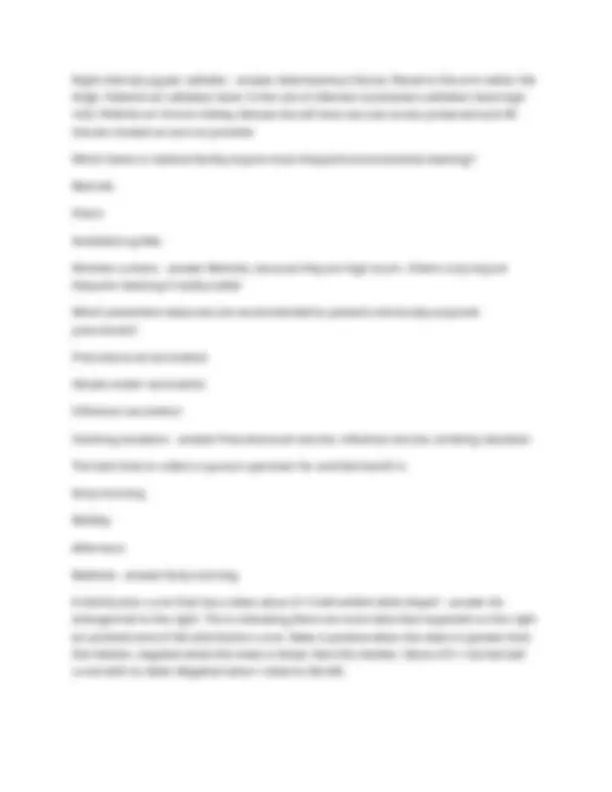
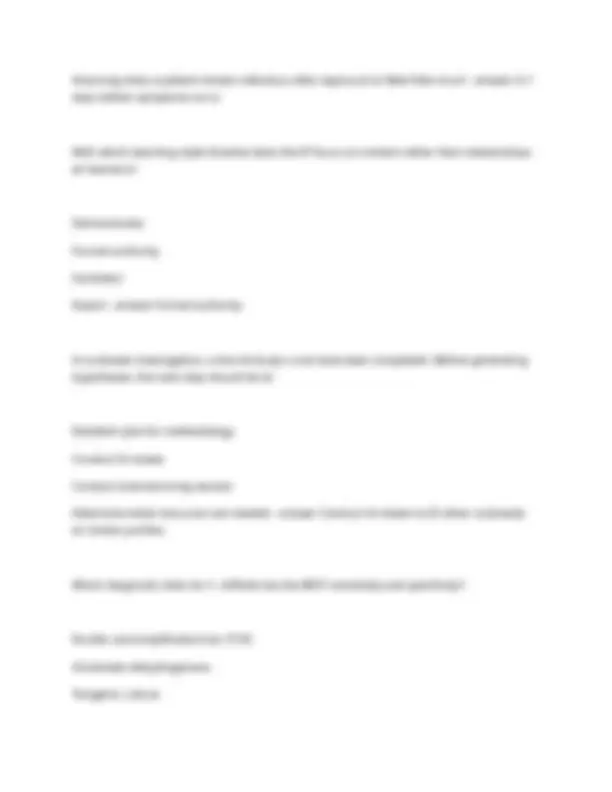
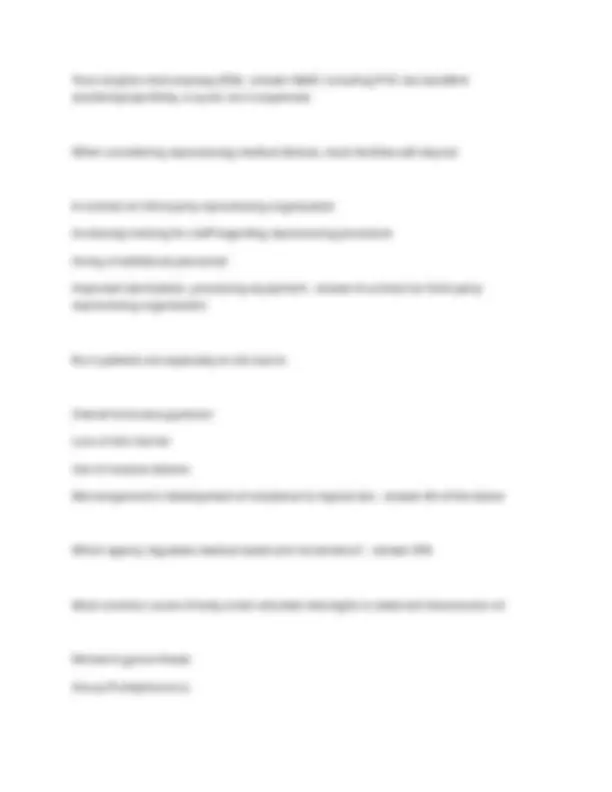

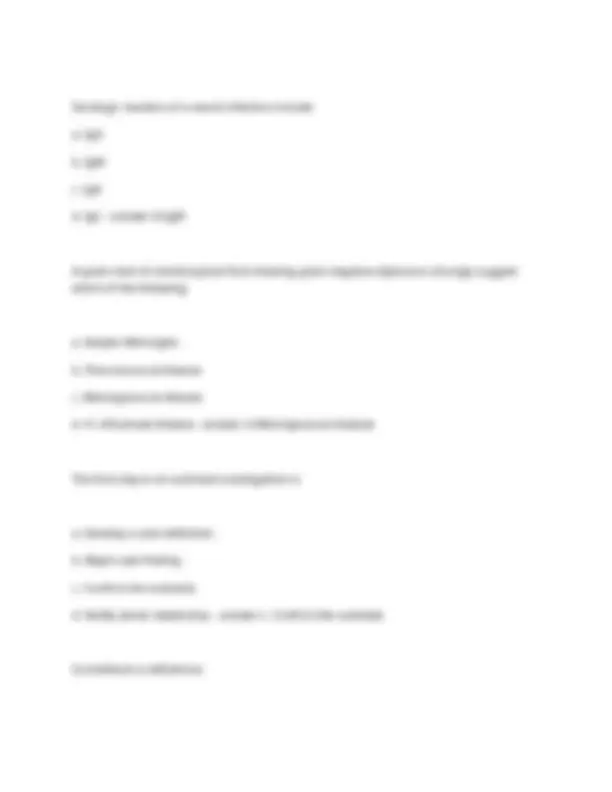
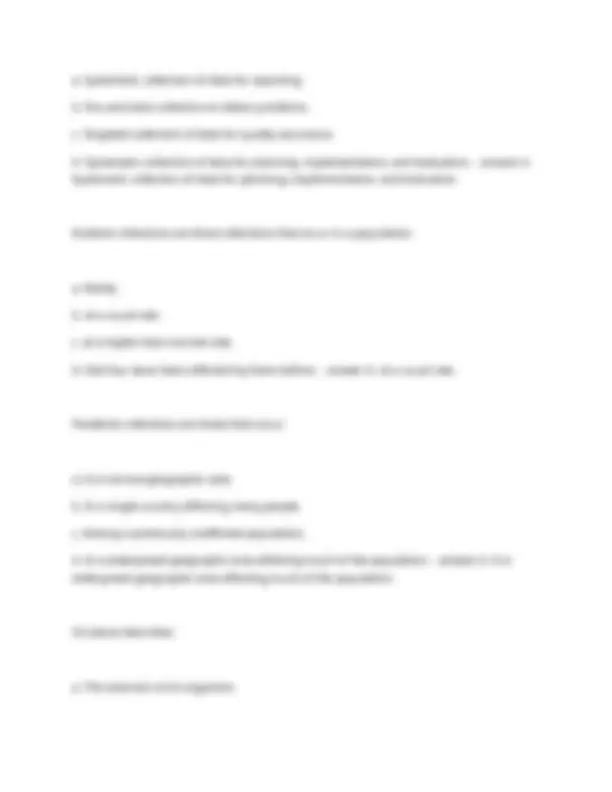
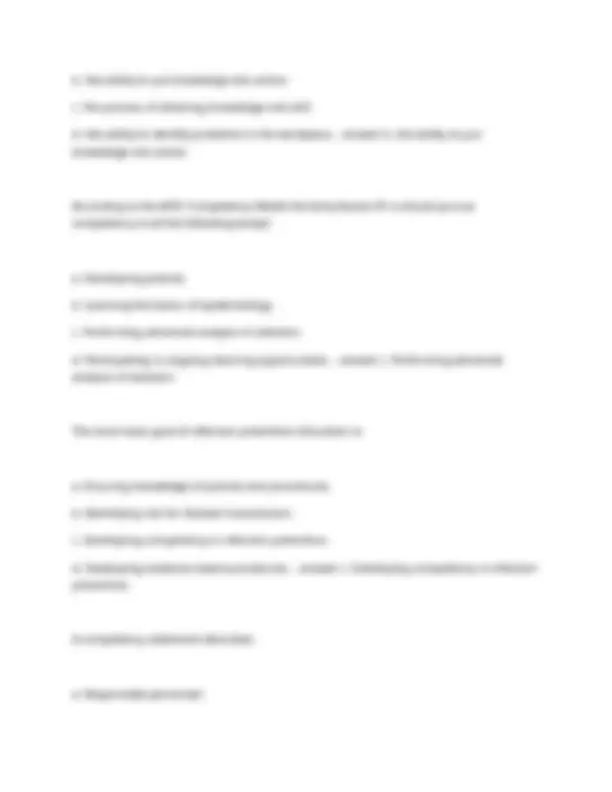
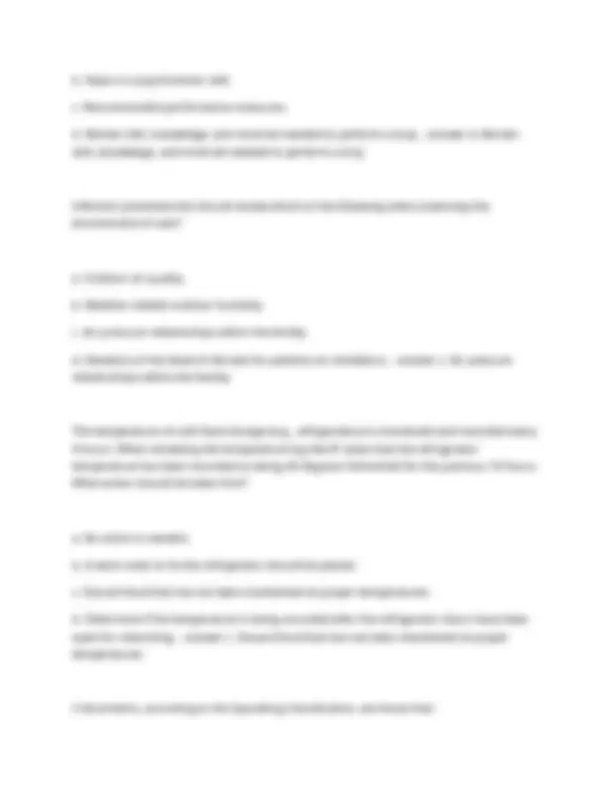
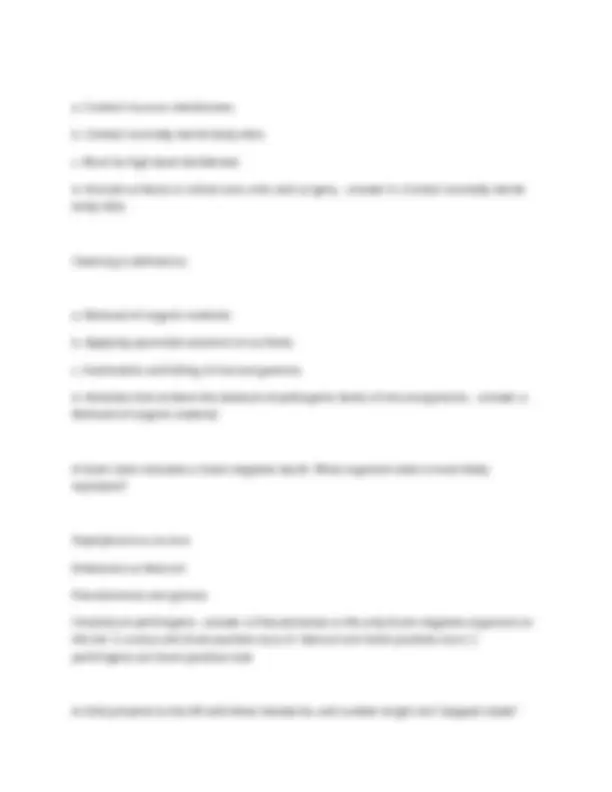

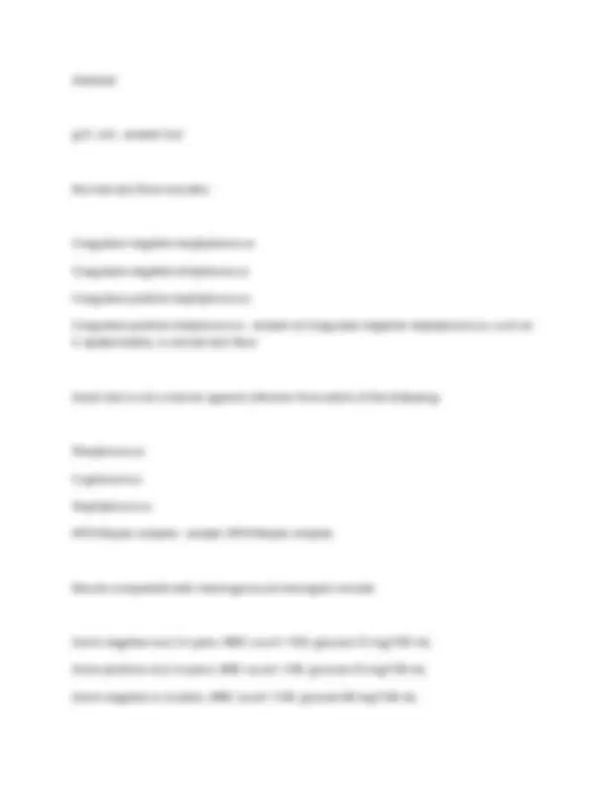
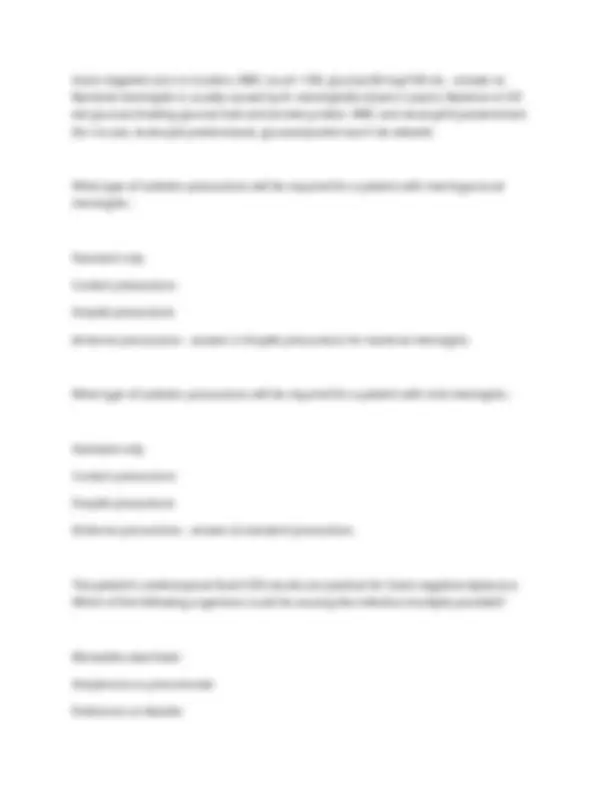
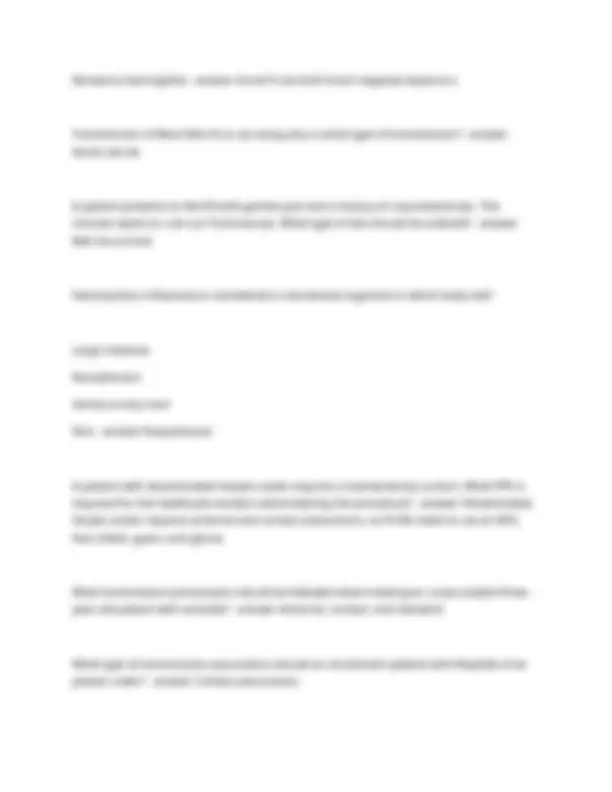
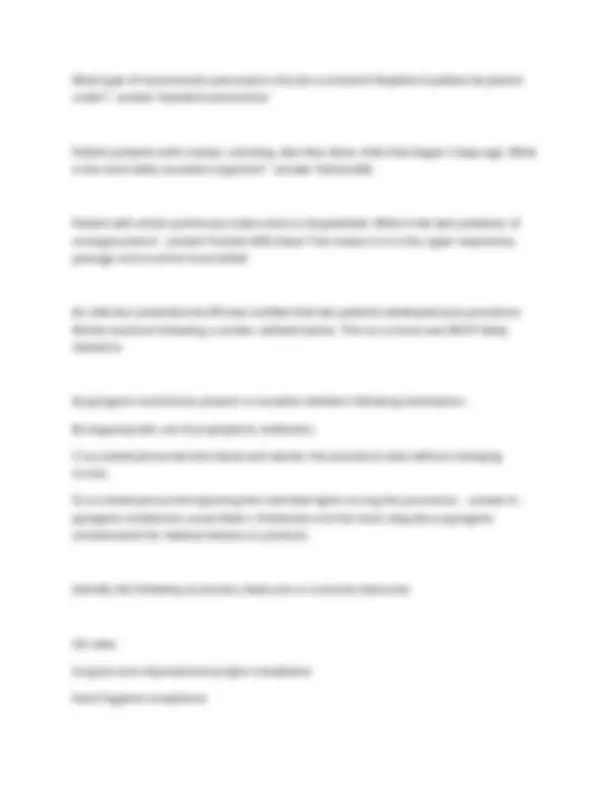
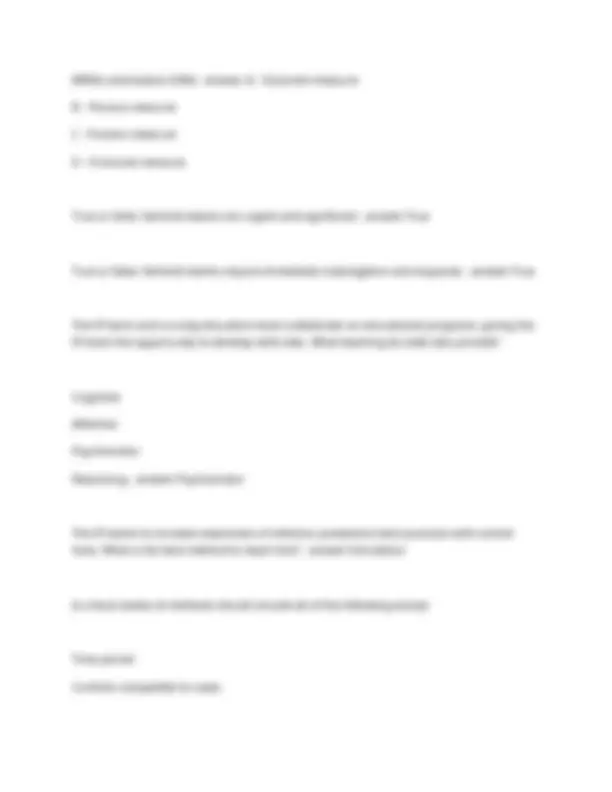
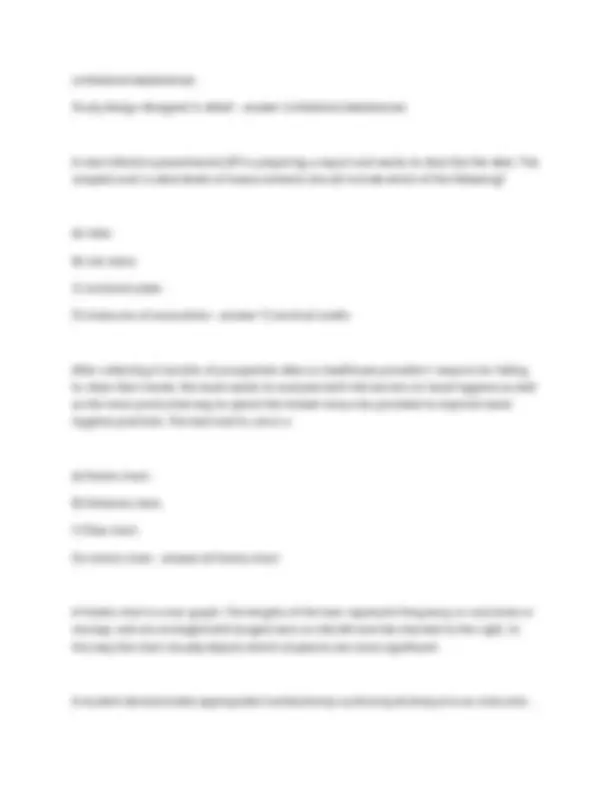
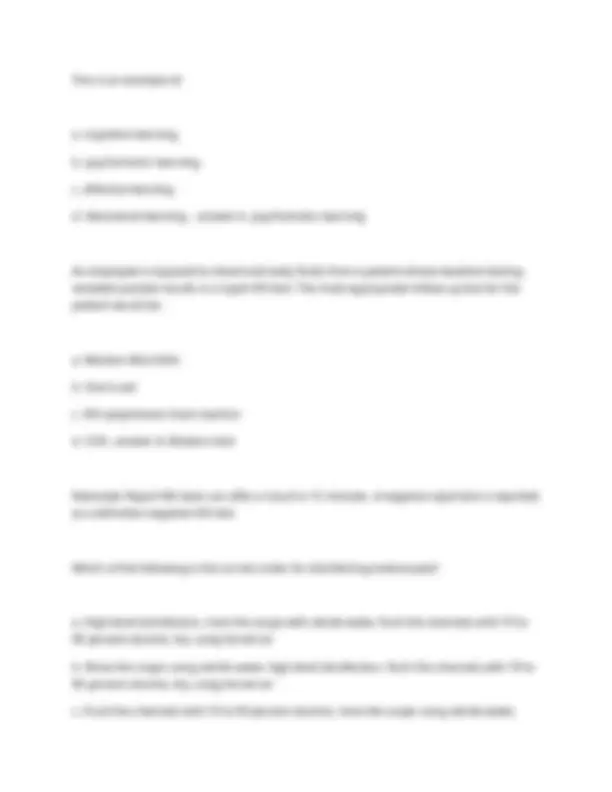
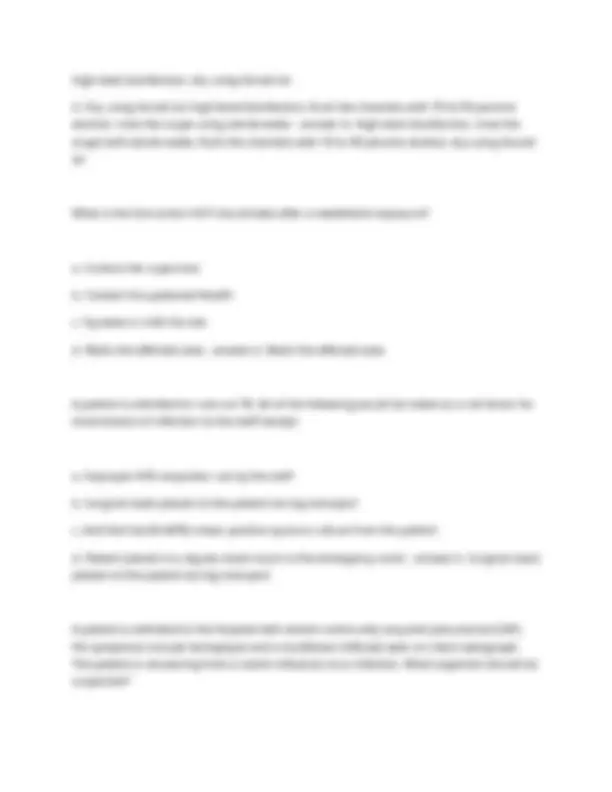
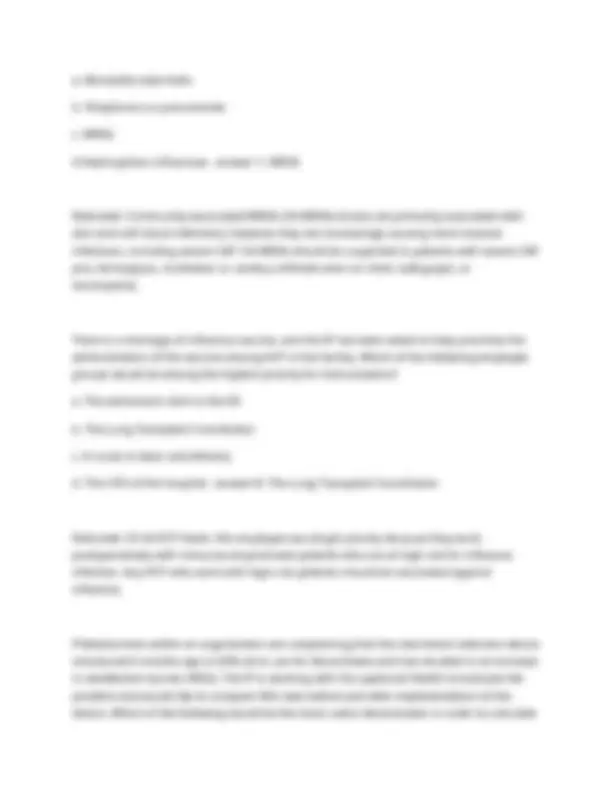
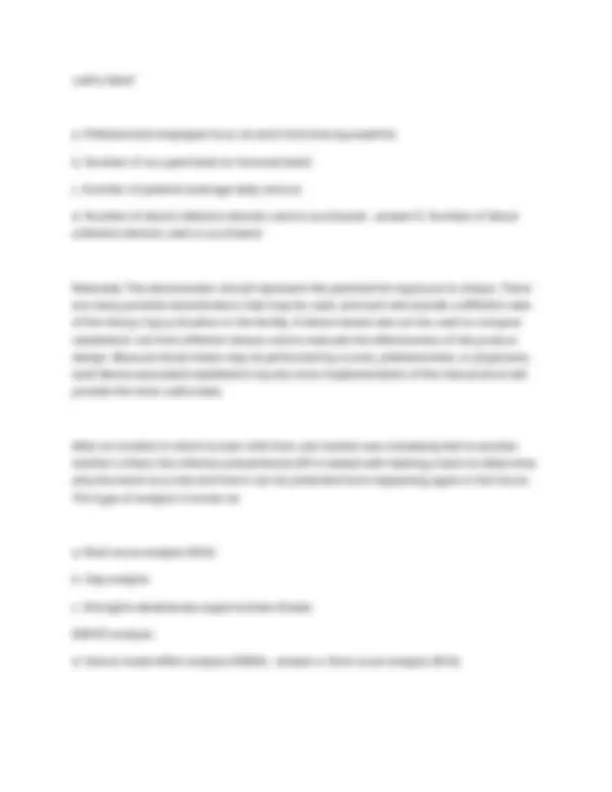
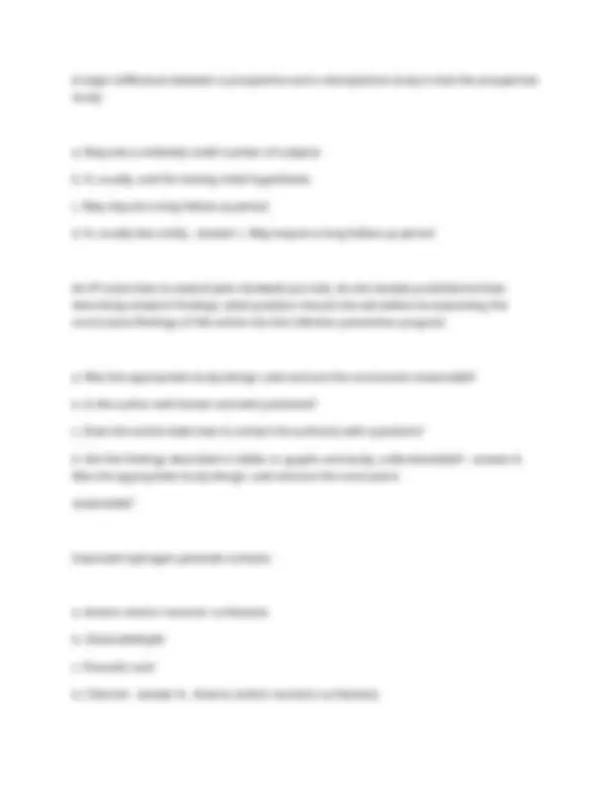
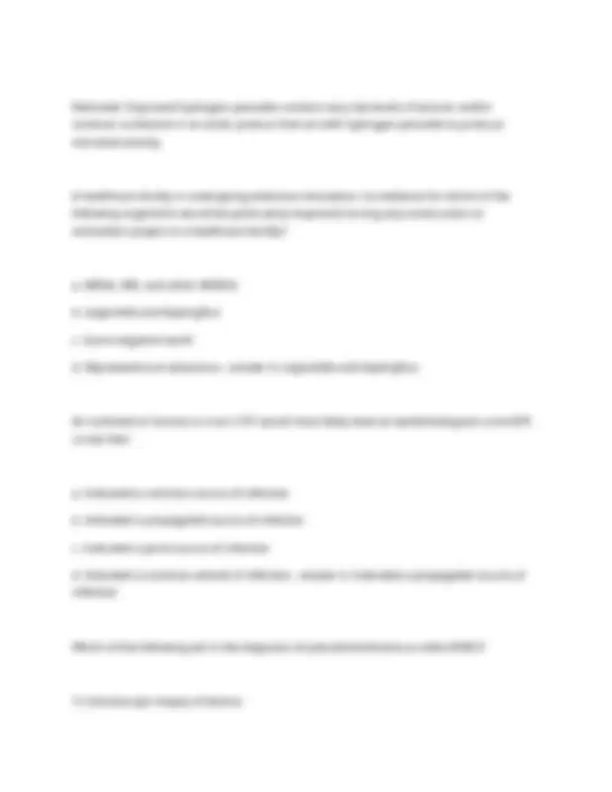
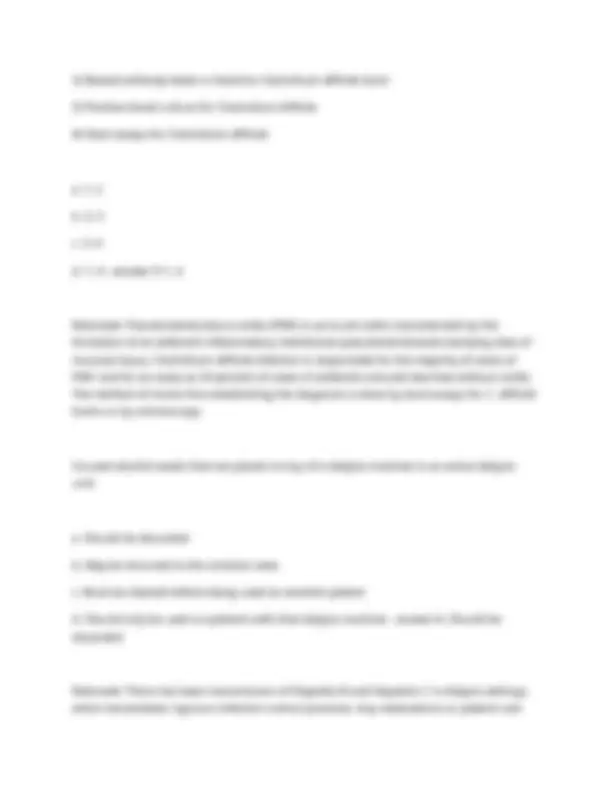
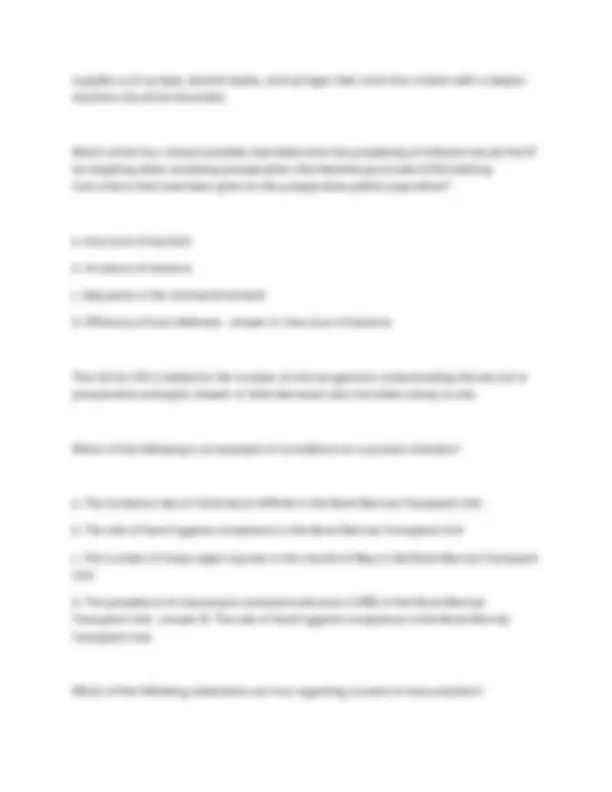
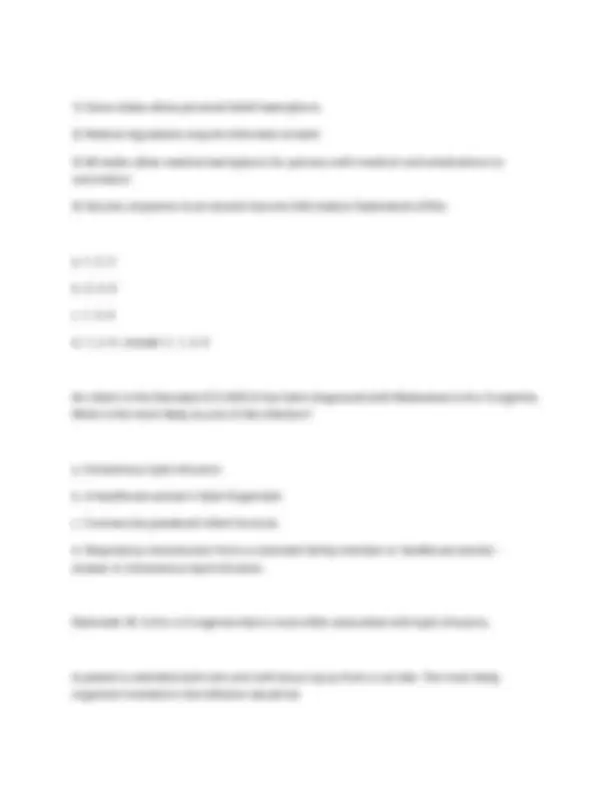
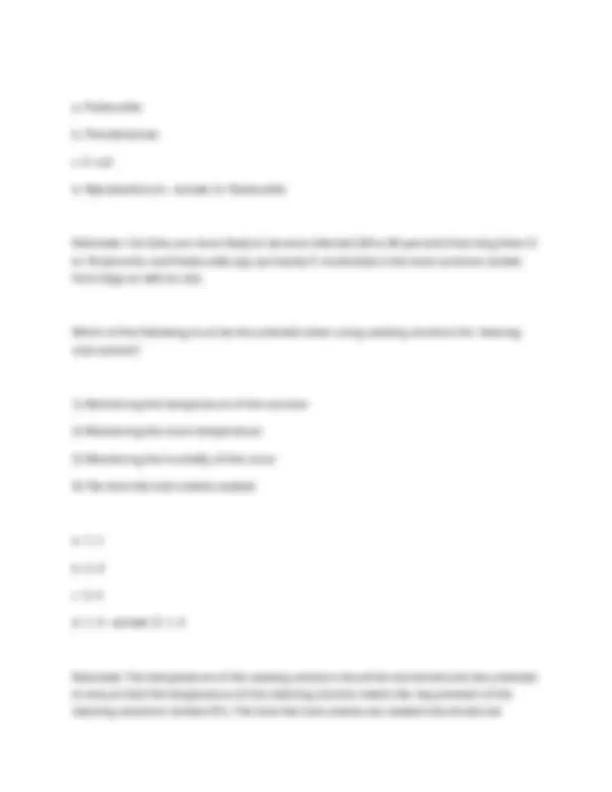
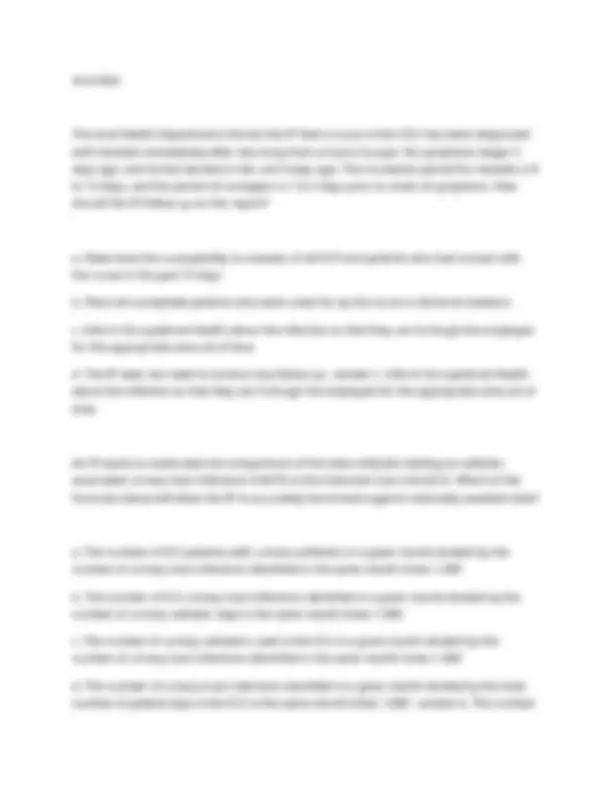
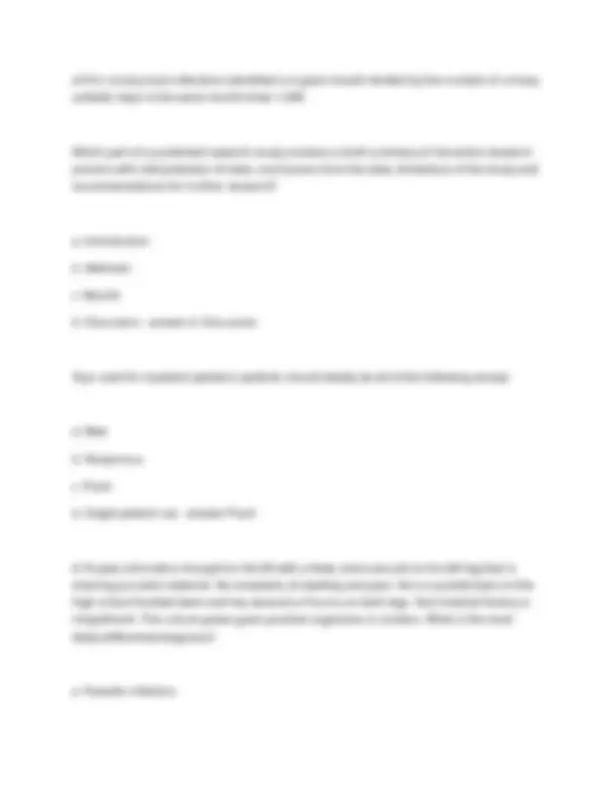
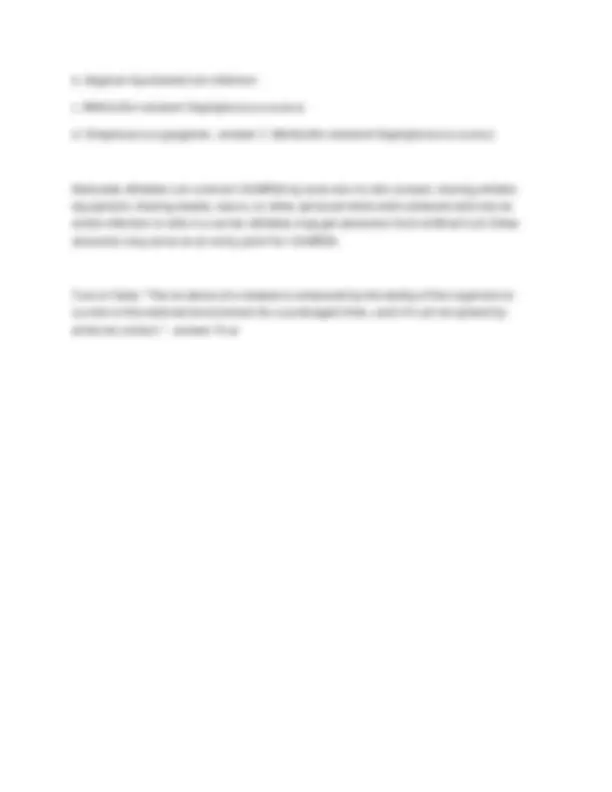


Study with the several resources on Docsity

Earn points by helping other students or get them with a premium plan


Prepare for your exams
Study with the several resources on Docsity

Earn points to download
Earn points by helping other students or get them with a premium plan
Community
Ask the community for help and clear up your study doubts
Discover the best universities in your country according to Docsity users
Free resources
Download our free guides on studying techniques, anxiety management strategies, and thesis advice from Docsity tutors
CIC Studying 2023- CIC Practice Exam Questions And Accurate Answers.
Typology: Exams
1 / 37

This page cannot be seen from the preview
Don't miss anything!






























Recipients of allogenic hematopoeietic stem transplantation (HSCT) should be placed in rooms with how many air exchanges per hour? 3 5 10 12 - answer 12. A greater number of air exchanges per hour prevent opportunistic infections among stem cell transplant recipients Because of the increased risk of infection with parenteral nutrition, the maximum infusion time for a parenteral lipid bag to run is? 6 hours 12 hours 18 hours 24 hours - answer Maximum 12 hours. Lipid emulsions pose greatest risk of contamination w/ bacteria or fungi The single most effective method of controlling hospital-acquired infections (HAI) is: Screening patients Isolating infected patients Handwashing Immunizing staff members - answer Handwashing If a breastfeeding mother develops mastitis, the most likely cause is: Infant colonized with Staphylococcus aureus Inadequate cleansing of breast
Maternal flora invading nipple Contaminated breast pump - answer Infant colonized with S. aureus. 50% of neonates become colonized w/ S. aureus w/in a few days of birth, & pass infection into breast If hair removal is required for a surgical procedure, the BEST method is to: Shave hair with razor immediately before the incision Remove hair with a depilatory the night before surgery Remove hair with clippers the night before surgery Remove hair with clippers immediately before incision - answer Remove hair with clippers immediately before incision. Clippers cause the least trauma, always immediately before surgery. Hair removal in general may not reduce rate of SSIs and may increase risk of infection IPC plan for an ambulatory surgery center should be evaluated (multiple options possible): I - annually II - monthly III - when risks change IV - when staff members change - answer I - annually and III - when risks change How long after exposure to Hep A are IgM antibodies to HAV detectable in the blood? 48 hrs 7 days 3 weeks 1-10 weeks - answer 3 weeks For patients who require hemodialysis, which type of vascular access device (VAD) poses the lowest risk of infection? Arteriovenous graft Subclavian catheter Arteriovenous fistula
How long does a patient remain infectious after exposure to West Nile virus? - answer 6- days before symptoms occur With which teaching style (Grasha) does the IP focus on content rather than relationships w/ learners?: Demonstrator Formal authority Facilitator Expert - answer Formal authority In outbreak investigation, a line list & epi curve have been completed. Before generating hypotheses, the next step should be to: Establish plan for methodology Conduct lit review Conduct brainstorming session Determine what resources are needed - answer Conduct lit review to ID other outbreaks w/ similar profiles Which diagnostic tests for C. difficile has the BEST sensitivity and specificity?: Nucleic acid amplification (ex. PCR) Glutamate dehydrogenase Toxigenic culture
Toxic enzyme immunoassay (EIA) - answer NAAT, including PCR, has excellent sensitivity/specificity, is quick, but is expensive When considering reprocessing medical devices, most facilities will require: A contract w/ third party reprocessing organization Increasing training for staff regarding reprocessing procedure Hiring of additional personnel Improved sterilization, processing equipment - answer A contract w/ third party reprocessing organization Burn patients are especially at risk due to: Overall immunosuppresion Loss of skin barrier Use of invasive devices Microorganisms's development of resistance to topical abx - answer All of the above Which agency regulates medical waste and incinerators? - answer EPA Most common cause of early-onset neonatal meningitis is maternal transmission of: Neisseria gonorrhoeae Group B streptococcus
Maintain better control of inventory Prevent waste of medical supplies Ensure adequate stock of medical supplies - answer Minimize costs of inventory Steps to reduce peritoneal dialysis catheter-associated infections include: I - Placing exist site of catheter at beltline II - Using double-cuff catheter III - Using strict aseptic technique IV - Avoiding baths/showers until insertion site heals - answer II - Using double-cuff catheter III - Using strict aseptic technique IV - Avoiding baths/showers until insertion site heals What clinical manifestation in a pediatric patient should give an IP a high index of suspicion for chicken pox?: A. Lesions first appear on the face or trunk B. Lesions first appear in the throat or mouth C. Bright red rash that appears on the cheeks D. Inflamed, red or peeling skin on knees and elbows - answer Lesions first appear on the face or trunk Select ALL the conditions that warrant airborne precautions:
A. Norovirus B. Hepatitis A C. Measles D. Varicella E. Disseminated Varicella Zoster F. Tuberculosis G. Whooping Cough H. RSV I. Epiglottitis - answer Measles, disseminated varicella zoster, tuberculosis Koplik spots are a symptom that is specific to which of the following viruses: a. Varicella b. Rubella c. Rubeola (10 day measles) d. Coxsackievirus - answer Rubeola (measles) Anti-HBc indicates: a. Prior infection with Hepatitis B. b. Status as a Hepatitis B carrier. c. New infection with Hepatitis B. d. Prior immunization with Hepatitis B vaccine. - answer a) Prior infection with Hepatitis B
a. Systematic collection of data for reporting. b. Focused data collection to detect problems. c. Targeted collection of data for quality assurance. d. Systematic collection of data for planning, implementation, and evaluation. - answer d. Systematic collection of data for planning, implementation, and evaluation Endemic infections are those infections that occur in a population: a. Rarely. b. at a usual rate. c. at a higher-than-normal rate. d. that has never been affected by them before. - answer b. at a usual rate. Pandemic infections are those that occur: a. In a narrow geographic area. b. In a single country affecting many people. c. Among a previously unaffected population. d. In a widespread geographic area affecting much of the population. - answer d. In a widespread geographic area affecting much of the population. Virulence describes: a. The reservoir of an organism.
b. A factor related to a disease host. c. The ability of an organism to invade a host and cause disease. d. The ease with which an organism can be killed/inactivated by disinfectants. - answer c. The ability of an organism to invade a host and cause disease. The Advisory Committee on Immunization Practices (ACIP) recommends which of the following vaccines for all persons over the age 65?: a. MMR b. TDaP c. Varicella d. Pneumococcal - answer d. Pneumococcal Important interventions to prevent central line-associated bloodstream infections include: a. Ensuring that central lines are rotated periodically. b. Ensuring all central lines are inserted in a procedure room. c. Ensuring that skin is cleansed with iodophor prior to insertion. d. Evaluating products to ensure all needed supplies are contained within insertion kits. - answer d. Evaluating products to ensure all needed supplies are contained within insertion kits Important interventions to prevent catheter-associated urinary tract infections include: a. Regularly changing urine collection bags.
b. the ability to put knowledge into action. c. the process of attaining knowledge and skill. d. the ability to identify problems in the workplace. - answer b. the ability to put knowledge into action According to the APIC Competency Model the Early Novice IP is should pursue competency in all the following except: a. Developing policies. b. Learning the basics of epidemiology. c. Performing advanced analysis of statistics. d. Participating in ongoing learning opportunities. - answer c. Performing advanced analysis of statistics The most basic goal of infection prevention education is: a. Ensuring knowledge of policies and procedures. b. Identifying risk for disease transmission. c. Developing competency in infection prevention. d. Developing evidence-based procedures. - answer c. Developing competency in infection prevention. A competency statement describes: a. Responsible personnel.
b. Steps in a psychomotor skill. c. Recommended performance measures. d. Worker skill, knowledge, and mind set needed to perform a duty. - answer d. Worker skill, knowledge, and mind set needed to perform a duty Infection preventionists should review which of the following when assessing the environment of care? a. Outdoor air quality. b. Weather related outdoor humidity. c. Air pressure relationships within the facility d. Elevation of the head of the bed for patients on ventilators. - answer c. Air pressure relationships within the facility The temperature of cold food storage (e.g., refrigerators) is monitored and recorded every 4 hours. When reviewing the temperature log the IP notes that the refrigerator temperature has been recorded as being 45 degrees Fahrenheit for the previous 16 hours. What action should be taken first? a. No action is needed. b. A work order to fix the refrigerator should be placed. c. Discard food that has not been maintained at proper temperatures. d. Determine if the temperature is being recorded after the refrigerator doors have been open for restocking. - answer c. Discard food that has not been maintained at proper temperatures Critical items, according to the Spaulding Classification, are those that:
rash. Which virus is the likely cause? Coxsackievirus Human metapneumovirus Paramyxovirus Parvovirus B19 - answer d) Parvovirus B19, which can cause a bright red facial rash in children referred to as a "slapped cheek" rash or Fifth Disease. A good resource is the Red Book for pediatric infectious diseases What is the specimen of choice for viral isolation from a patient with suspected mumps? Buccal swab Blood culture Skin scraping Stool - answer a) Buccal swab, and you would need to perform a PCR test on it There has been an increased number of positive surgical site cultures from patients who don't have clinical infections. You suspect the specimens are being improperly collected. What is the most way to collect a wound culture? A - From drainage after cleaning the wound surface B - From the purulent material on the wound dressing C - From the wound prior to cleaning D - From the skin surface surrounding the wound - answer A - From drainage after cleaning the wound surface
b) is incorrect because it's not sterile c) is incorrect because you need to collect drainage expressed from the wound after cleaning d) is incorrect because of contamination from normal skin flora At what point(s) in the cycle of disease transmission can we as infection preventionists break the chain of infection, and how can we interfere at each point? Susceptible host Infectious microbe Reservoir Portal of exit Mode of transmission Portal of entry - answer D, E, and F - these are the points where we can interfere D: prevent/cover coughing, sneezing, bleeding, feces E: By using contact/airborne/droplet precautions, preventing transmission to vehicle/insect vector F: Protect wound opening/mucus membrane via sterilization/disinfection of devices Match the following bacteria to a the body site where they are typically found (not causing disease): a) Streptococcus - answer Nasopharynx
disease): g) E. coli - answer Gut Normal skin flora includes: Coagulase negative staphylococcus Coagulase negative streptococcus Coagulase positive staphylococcus Coagulase positive streptococcus - answer a) Coagulase negative staphylococcus, such as S. epidermiditis, is normal skin flora Intact skin is not a barrier against infection from which of the following: Streptococcus Cryptococcus Staphylococcus HPV/Herpes simplex - answer HPV/Herpes simplex Results compatible with meningococcal meningitis include: Gram negative cocci in pairs, WBC count >100, glucose 25 mg/100 mL Gram positive cocci in pairs, WBC count >100, glucose 25 mg/100 mL Gram negative in clusters, WBC count >100, glucose 80 mg/100 mL
Gram negative cocci in clusters, WBC count >100, glucose 80 mg/100 mL - answer a) Bacterial meningitis is usually caused by N. meningitidis (Gram (-) pairs). Bacteria in CSF eat glucose (making glucose low) and secrete protein. WBC and neutrophil predominant (for viruses, leukocyte predominant, glucose/protein won't be altered) What type of isolation precautions will be required for a patient with meningococcal meningitis.: Standard only Contact precautions Droplet precautions Airborne precautions - answer c) Droplet precautions for bacterial meningitis What type of isolation precautions will be required for a patient with viral meningitis.: Standard only Contact precautions Droplet precautions Airborne precautions - answer a) standard precautions The patient's cerebrospinal fluid (CSF) results are positive for Gram negative diplococci. Which of the following organisms could be causing the infection (multiple possible)? Moraxella catarrhalis Streptococcus pneumoniae Enterococcus faecalis